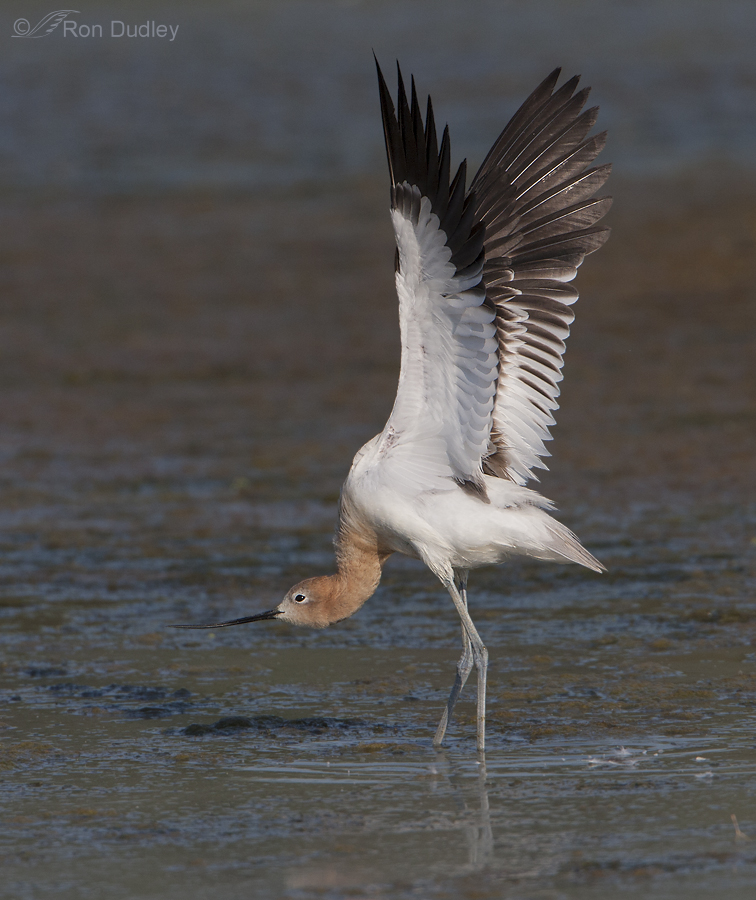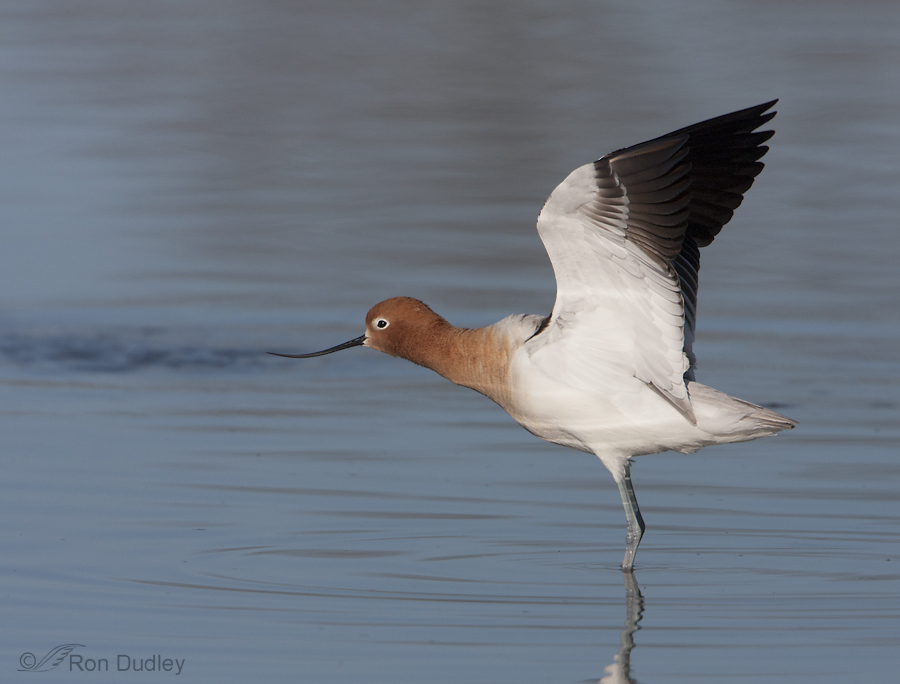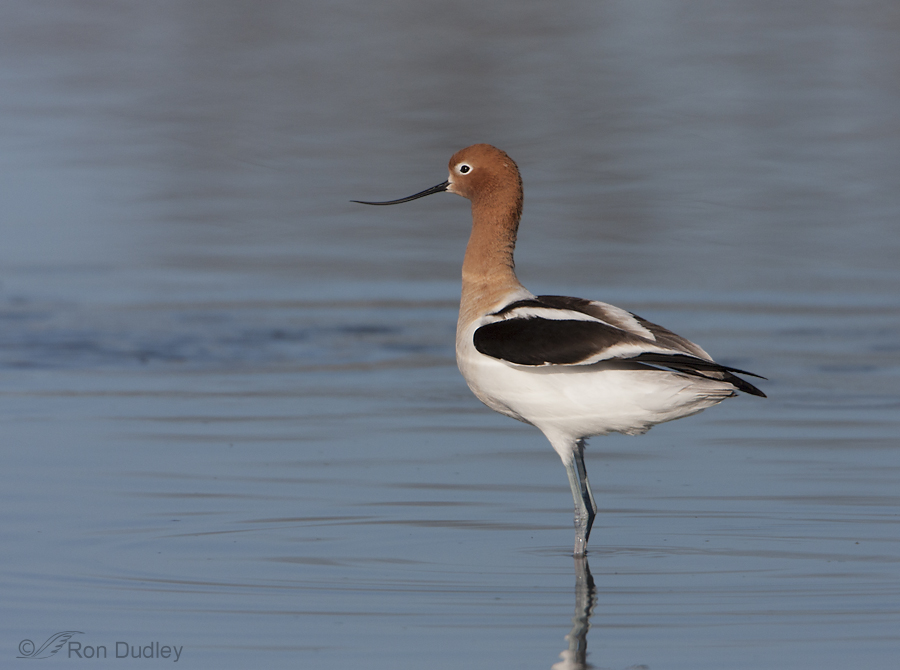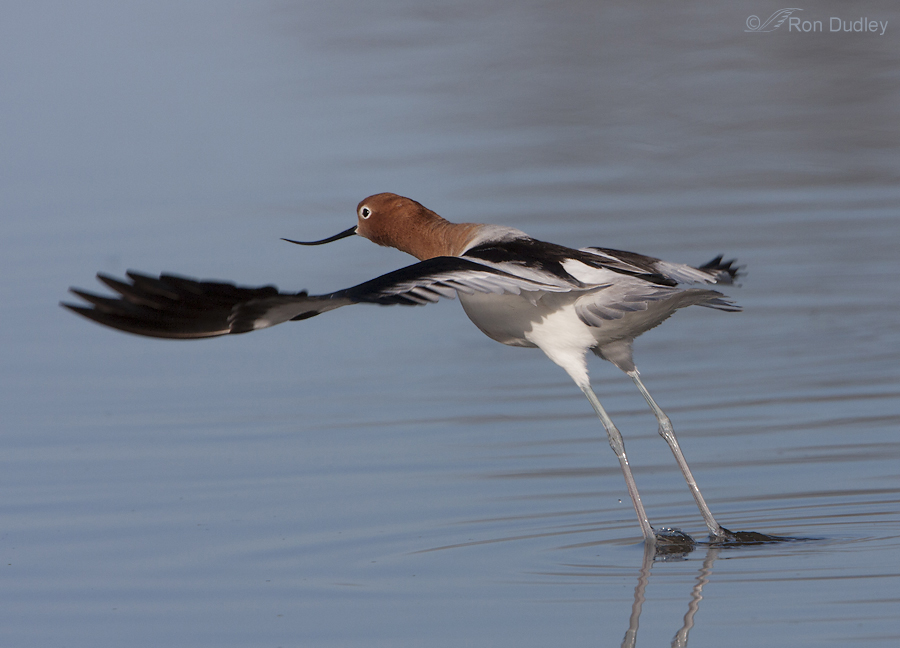In my experience American Avocets have two primary “styles” of stretching. When they stretch a single wing they extend it to the side with one leg stretched out behind. But they also use what’s called the “two wing stretch” and this style is often a precursor of imminent behavior – takeoff.
1/1600, f/8, ISO 400, 500 f/4, 1.4 tc
In the two-wing stretch they fully extend those graceful wings vertically and at the same time they recurve their neck downward with the head and long bill extended horizontally. If they’re standing in deeper water, only their unusually long legs prevent the immersion of their heads during the process.
When you see this pose the bird is very likely about to take off. Here’s what BNA has to say about the behavior: “Two-wing stretch often appears to be preflight intention movement;”
The following three images illustrate that behavior (which I’ve written about previously on this blog).
1/3200, f/8, ISO 400, 500 f/4, 1.4 tc
This is a different avocet coming out of a two-wing stretch. The wings are coming down and the head and neck are being lifted back up.
1/3200, f/8, ISO 400, 500 f/4, 1.4 tc
The bird folds its wings back into normal position for an instant and looks around, apparently to decide direction of take-off …
1/3200, f/8, ISO 400, 500 f/4, 1.4 tc (image posted once before)
and in the very next frame it lifts off.
The ability to predict behaviors can be of significant value to bird photographers (and to birders). The greater accuracy you have in anticipating time and direction of take-off, the better chance you have of getting acceptable take-off images where no body parts have been clipped or cut off.
I just wish this avocet hadn’t taken off away from me…
Ron






I think I have seen this before and thought it was a wing flutter just before take off. I am guessing that these are fast shots which clarify what I have seen as a blur.
I LOVE that first pose! Never seen that before and worth the capture and sharing. Thanks, Ron.
You are very hard on yourself. Most of us would be very, very happy with that take-off shot even though the bird showed no consideration and headed the wrong way.
And I love the two wing stretch and flex. Thank you.
Thanks so much–I’ll watch for this behavior and try to get some take-off shots. I really appreciate the images and the tips!
You’re very welcome, Sharon.
This is very informative. I have started following your blog and now it is more interesting to watch your photos.
Welcome aboard, Divya. Hope you enjoy your visits here.
Nice photos, as usual. I’m with Patty on the wing thing. Fortunately, with this bird, the two left wings is not so difficult to decipher as the hawk was. Even understanding the hawk still hasn’t helped with the photo. 🙂
I didn’t see the “two left wing” thing at first, Susan – had to look for it…
Sorry about that! 🙂
I’ve never seen this beautiful bird even though I have looked for it where it has been sited.
Your fantastic shots make up for my lack of siting. Thanks so very much for sharing!
Charlotte
I hope you get to see some soon, Charlotte. I think they’re most beautiful when they’re in breeding plumage.
Beautiful, laser-like in detail, photos once again. For me, this last frame, helps demystify “the hawk with the mohawk”. Looking at this shot, I can see what happened to create that illusion…thank goodness, because it was driving me nuts!
I’m glad you finally got some relief from the frustration of that illusion, Patty!
IDK Ron, I think the take off away from you is a very cool picture. Great behavior shots. I just LOVE Avocets!
Thanks, Deb – glad you like it.
Very nice images and an interesting post. I agree that the ability to predict behaviours is really valuable. I’m hoping to get over to the best birding spot near Melbourne (Western Treatment Plant at Werribee) this week as we are having a burst of summer to start off spring with mid 20sC temperatures forecast, and will try to observe if ours follow that same sequence.
It’s interesting how birds seem to be able to silently communicate to a partner/flock to take off too.
That’s right, Sonja – birds of the same species read behaviors of their own kind so very well. I also think that closely related species sometimes read each others behaviors – avocets and stilts for example.
I wish you luck at Werribee!